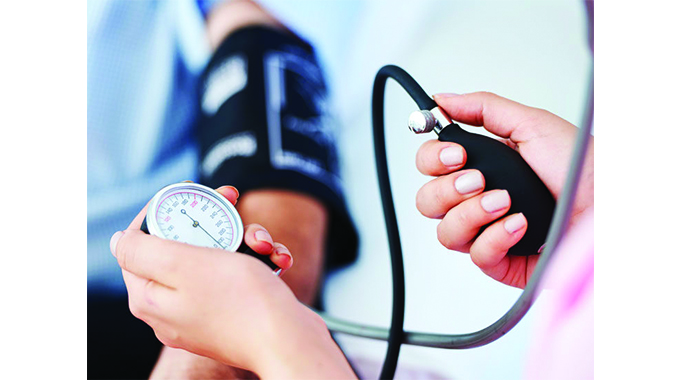Hypertension the silent killer

Hypertension, (elevated blood pressure) the silent killer, commonly known as BP is a condition that has affected many people mostly unexpectedly and unknown to the patient. The body uses blood pressure to pump blood to the body, where the blood supplies oxygen, nutrients and takes away waste products from organs. This blood pressure is maintained in range of 100-139 systolic (top number) and 60-89 diastolic (bottom number).
The concept of blood pressure measurement has been developed over the centuries from as early as 1733 when Hales Stephen inserted a small brass pipe into a horse’s blood vessel, connected to a glass tube column.
He noticed a rise in the column of glass as the artery was pumping blood. Over time scientist found a way of measuring the blood pressure without puncturing a vein; they initially used water cuffs which were later replaced with air in the cuff. The air was used to compress the artery till it was no longer felt beating/pulsating.
Then slowly release the pressure whilst recording/registering the pressures on the usual mercury manometer. When the pressure was slowly released the mercury level in the manometer fell, and the reading at which the pulse reappeared was the systolic BP.
In 1905 N C Korotkoff, a Russian surgeon, reported that by placing a stethoscope over the brachial artery at the cubital fossa (anterior aspect of elbow joint), tapping sounds could be heard as the cuff was deflated, caused by blood flowing back into the artery. This is the concept still used to measure BP and to which anybody who has ever been a patient has probably been subjected.
Elevated arterial blood pressure is a major cause of premature blood vessel (vascular) disease leading to cerebrovascular events commonly known as strokes, ischaemic heart disease and lower limb blood vessel disease. The risk of mortality or morbidity rises progressively with increasing systolic and diastolic pressures.
All adults should have blood pressure measured routinely at least every five years until the age of 80 years. Seated blood pressure when measured after five minutes’ resting with appropriate cuff size and arm supported is usually sufficient; the cuff should not be too tight or too loose. If the cuff is too tight it will give falsely high readings; conversely, if the cuff is too loose, inaccurately low values will be taken.
Two consistent blood pressure measurements are needed to estimate blood pressure, and more are recommended if there is variation in the pressure. When assessing the cardiovascular risk, the average blood pressure at separate visits is more accurate than measurements taken at a single visit.
The majority (80–90 percent) of patients with hypertension have primary elevation of blood pressure, i.e. essential hypertension of unknown cause.
Blood pressure tends to run in families and children of hypertensive parents tend to have higher blood pressure than age-matched children of parents with normal blood pressure. This familial concordance of blood pressure may be explained, at least in part, by shared environmental influences.
Low birth weight is associated with subsequent high blood pressure. This relationship may be due to fetal adaptation to intrauterine undernutrition with long-term changes in blood vessel structure or in the function of crucial hormonal systems.
Environmental factors that have been proposed, the following seem to be the most significant:
- Obesity — Fat people have higher blood pressures than thin people. There is a risk, however, of overestimation if the blood pressure is measured with a small cuff. Adjust the bladder size to the arm circumference.
- A high sodium intake has been suggested to be a major determinant of blood pressure differences between and within populations around the world. Populations with higher sodium intakes have higher average blood pressures than those with lower sodium intake. Migration from a rural to an urban environment is associated with an increase in blood pressure that is in part related to the amount of salt in the diet. Studies of the restriction of salt intake have shown a beneficial effect on blood pressure in hypertensive people. There is some evidence that a high potassium diet can protect against the effects of a high sodium intake; bananas are a good source of potassium.
- While acute pain or stress can raise blood pressure, the relationship between chronic stress and blood pressure is uncertain.
- The other 10 percent of cases is caused by identifiable causes and is called secondary hypertension; this is where blood pressure elevation is the result of a specific and potentially treatable cause. Common secondary causes include kidney disease, heart disease, thyroid disease (endocrine-hormone driven), Obstructive sleep apnea and phaeochromocytoma (excess-adrenaline producing cancer).
Long-term/Overuse/misuse/abuse of certain drugs may trigger hypertension;
- Non-Steroidal Anti Inflammatory Drugs (NSAIDs) like indomentacin, brufen, diclofenac, asprin.
- Oral contraceptives- control.
- Steroids-prednisolone, dexamethasone.
- Illegal drugs, such as cocaine and amphetamines.
Risk factors of high blood pressure include;
• Age. The risk of high blood pressure increases as you age.
• Family history.
• Being overweight or obese.
• Not being physically active.
• Using tobacco. Not only does smoking or chewing tobacco immediately raise your blood pressure temporarily, but the chemicals in tobacco can damage the lining of your artery walls.
This can cause your arteries to narrow and increase your risk of heart disease.
Second hand smoke also can increase your heart disease risk.
• Too much salt (sodium) in your diet can cause your body to retain fluid, which increases blood pressure.
• Too little potassium in your diet, potassium helps balance the amount of sodium in your cells.
A proper balance of potassium is critical for good heart health.
Bananas are a good source of potassium.
• Drinking too much alcohol.
Having more than one drink a day for women and more than two drinks a day for men may affect your blood pressure.
• High levels of stress can lead to a temporary increase in blood pressure.
Stress-related habits such as eating more, using tobacco or drinking alcohol can lead to further increases in blood pressure.
• Certain chronic conditions. Including kidney disease, diabetes and sleep apnea.
• Sometimes pregnancy may predispose mothers to high blood pressure.
Till next week












Comments